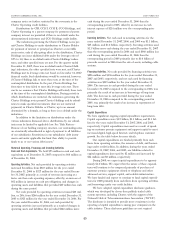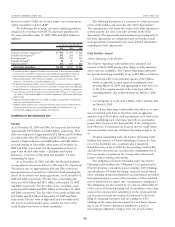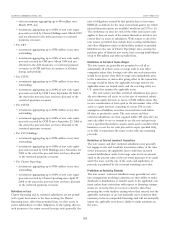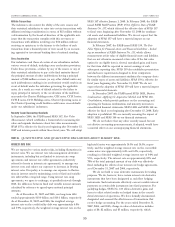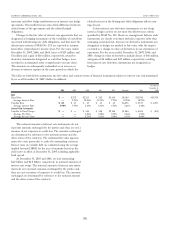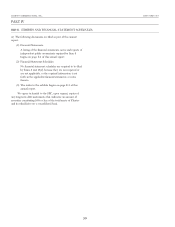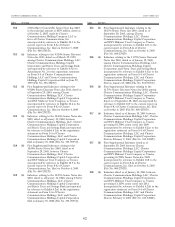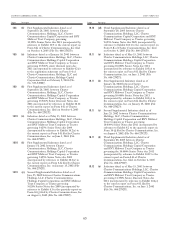Charter 2007 Annual Report Download - page 66
Download and view the complete annual report
Please find page 66 of the 2007 Charter annual report below. You can navigate through the pages in the report by either clicking on the pages listed below, or by using the keyword search tool below to find specific information within the annual report.
Affiliate Transactions
The indentures also restrict the ability of the note issuers and
their restricted subsidiaries to enter into certain transactions with
affiliates involving consideration in excess of $15 million without
a determination by the board of directors of the applicable note
issuer that the transaction complies with this covenant, or
transactions with affiliates involving over $50 million without
receiving an opinion as to the fairness to the holders of such
transaction from a financial point of view issued by an account-
ing, appraisal or investment banking firm of national standing.
Cross Acceleration
Our indentures and those of certain of our subsidiaries include
various events of default, including cross acceleration provisions.
Under these provisions, a failure by any of the issuers or any of
their restricted subsidiaries to pay at the final maturity thereof
the principal amount of other indebtedness having a principal
amount of $100 million or more (or any other default under any
such indebtedness resulting in its acceleration) would result in an
event of default under the indenture governing the applicable
notes. As a result, an event of default related to the failure to
repay principal at maturity or the acceleration of the indebted-
ness under the Charter Holdings notes, CIH notes, CCH I notes,
CCH II notes, CCO Holdings notes, Charter Operating notes or
the Charter Operating credit facilities could cause cross-defaults
under our subsidiaries’ indentures.
Recently Issued Accounting Standards
In September 2006, the FASB issued SFAS 157, Fair Value
Measurements, which establishes a framework for measuring fair
value and expands disclosures about fair value measurements.
SFAS 157 is effective for fiscal years beginning after November 15,
2007 and interim periods within those fiscal years. We will adopt
SFAS 157 effective January 1, 2008. In February 2008, the FASB
issued FASB Staff Position (FSP) 157-2, Effective Date of FASB
Statement No. 157, which deferred the effective date of SFAS 157
to fiscal years beginning after November 15, 2008 for nonfinan-
cial assets and nonfinancial liabilities. We do not expect that the
adoption of SFAS 157 will have a material impact on our
financial statements.
In February 2007, the FASB issued SFAS 159, The Fair
Value Option for Financial Assets and Financial Liabilities – Includ-
ing an amendment of FASB Statement No. 115, which allows
measurement at fair value of eligible financial assets and liabilities
that are not otherwise measured at fair value. If the fair value
option for an eligible item is elected, unrealized gains and losses
for that item shall be reported in current earnings at each
subsequent reporting date. SFAS 159 also establishes presentation
and disclosure requirements designed to draw comparison
between the different measurement attributes the company elects
for similar types of assets and liabilities. SFAS 159 is effective for
fiscal years beginning after November 15, 2007. We do not
expect that the adoption of SFAS 159 will have a material impact
on our financial statements.
In December 2007, the FASB issued SFAS 141R, Business
Combinations: Applying the Acquisition Method, and SFAS 160,
Consolidations, which provide guidance on the accounting and
reporting for business combinations and minority interests in
consolidated financial statements. SFAS 141R and SFAS 160 are
effective for fiscal years beginning after December 15, 2008. Early
adoption is prohibited. We are currently assessing the impact of
SFAS 141R and SFAS 160 on our financial statements.
We do not believe that any other recently issued, but not
yet effective accounting pronouncements, if adopted, would have
a material effect on our accompanying financial statements.
ITEM 7A. QUANTITATIVE AND QUALITATIVE DISCLOSURES ABOUT MARKET RISK.
INTEREST RATE RISK
We are exposed to various market risks, including fluctuations in
interest rates. We use interest rate risk management derivative
instruments, including but not limited to interest rate swap
agreements and interest rate collar agreements (collectively
referred to herein as interest rate agreements), to manage our
interest costs and reduce our exposure to increases in floating
interest rates. Our policy is to manage our exposure to fluctua-
tions in interest rates by maintaining a mix of fixed and variable
rate debt within a targeted range. Using interest rate swap
agreements, we agree to exchange, at specified intervals through
2013, the difference between fixed and variable interest amounts
calculated by reference to agreed-upon notional principal
amounts.
As of December 31, 2007 and 2006, our long-term debt
totaled approximately $19.9 billion and $19.1 billion, respectively.
As of December 31, 2007 and 2006, the weighted average
interest rate on the credit facility debt was approximately 6.8%
and 7.9%, respectively, the weighted average interest rate on the
high-yield notes was approximately 10.3% and 10.3%, respec-
tively, and the weighted average interest rate on the convertible
senior notes was approximately 6.4% and 6.9%, respectively,
resulting in a blended weighted average interest rate of 9.0% and
9.5%, respectively. The interest rate on approximately 85% and
78% of the total principal amount of our debt was effectively
fixed, including the effects of our interest rate hedge agreements,
as of December 31, 2007 and 2006, respectively.
We do not hold or issue derivative instruments for trading
purposes. We do, however, have certain interest rate derivative
instruments that have been designated as cash flow hedging
instruments. Such instruments effectively convert variable interest
payments on certain debt instruments into fixed payments. For
qualifying hedges, SFAS No. 133 allows derivative gains and
losses to offset related results on hedged items in the consoli-
dated statement of operations. We have formally documented,
designated and assessed the effectiveness of transactions that
receive hedge accounting. For the years ended December 31,
2007, 2006, and 2005, change in value of derivatives includes
gains of $0, $2 million, and $3 million, respectively, which
CHARTER COMMUNICATIONS, INC. 2007 FORM 10-K
55


